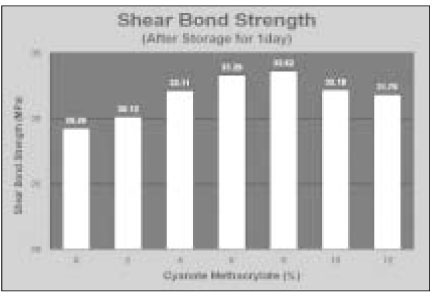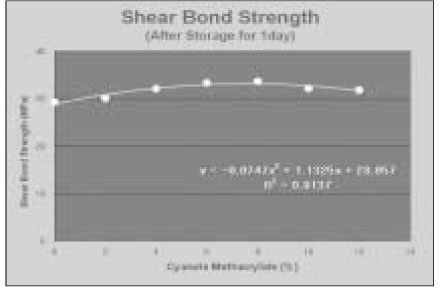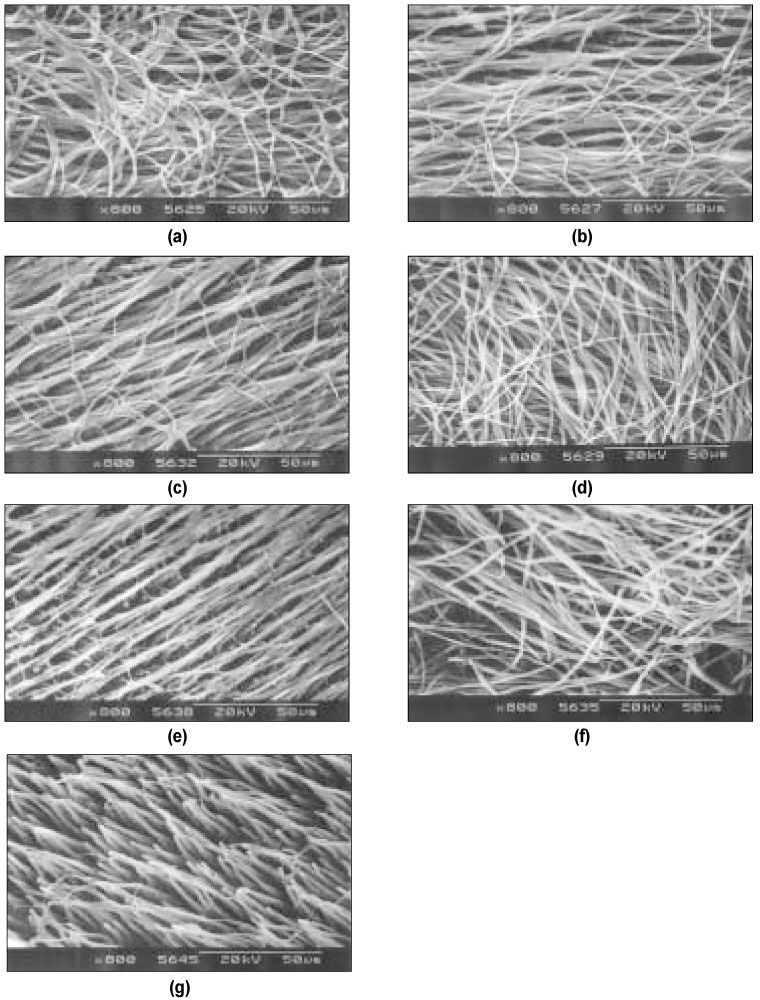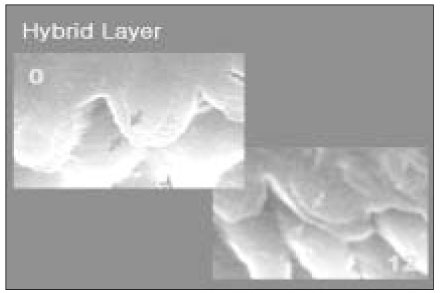J Korean Acad Conserv Dent.
2007 May;32(3):236-247. 10.5395/JKACD.2007.32.3.236.
The effect of cyanate methacrylate on the shear bond strengths to dentin
- Affiliations
-
- 1Department of Conservative Dentistry, Division of Dentistry, Graduate of Kyung Hee University, Korea. psangjin@khu.ac.kr
- KMID: 2175877
- DOI: http://doi.org/10.5395/JKACD.2007.32.3.236
Abstract
- The purpose of this study was to evaluate the effects of cyanate methacylate on the shear bond strengths to bovine dentin surfaces as a dentin primers. Seven experimental adhesives were made with different mass fraction of Isocyanatoetylmethacrylate (IEM), 40wt% HEMA (Wako Pure Chemical Industries Osaka, Japan), 0.6% camphoroquinone, 0.4% amine and ethanol as balance. dentin bonding agents (0, 2, 4, 6, 8, 10, 12%) were made and applied on the surface of bovine dentin specimens of 7 experimental groups. Shear bond strengths were measured using a universal testing machine (Instro 4466). To identify the ratio and modes of cohesive failures, microscopic examinationn was performed. The ultra-structure of resin tags were observed under scanning electron microscope. The results were as follows ; 1) A higher shear bond strengths (33.62 MPa) in group 8% of Cyanate methacrylate to dentin were found, but there were no statistically significancy between Groups (p > 0.05). 2) The higher ratio of cohesive failures mode in group 2, 6, an 10% could be seen than that in any other groups. 3) A shorter resin tags were observed in all experimental groups. This could be resulted that the preventing from the cyanate methacrylate penetrate into dentin owing to reacting it with dentin collagen. Therefore the resin tags were shorter in lengths. Whether the higher bonding strengths of dentin bonding agents can be affected was not been assured with statistic results. The results indicated that the relation between tensile strengths of the dentin adhesives to bovine dentin and resin tags formed into the dentin could not affected. The main reason of increasing the shear bond strength to bovine dentin in experimental groups could not be assured.
Keyword
MeSH Terms
Figure
Reference
-
1. Buonocore MG. A simple method of increasing the adhesion of acrylic filling materials to enamel surfaces. J Dent Res. 1955. 34:849–853.
Article2. Bowen RL, Cobb EN, Rapson JE. Adhesive bonding of various materials to hard tooth tissues: improvement in bond strength to dentin. J Dent Res. 1982. 61:1070–1076.
Article3. Hulmes DJ, Wess TJ, Prockop DJ, Fratzl P. Radial packing, order, and disorder in collagen fibrils. Biophys J. 1995. 68:1661–1670.
Article4. Nakabayashi N, Pashley DH. Hybridization of dental hard tissues. 1998. Quintessence Publishing Co.;1–107.5. Van Meerbeek B, Perdigao J, Lambrechts P, Vanherle G. The clinicabonding to dentin with ferrous chloride primers and tri-n-butyl borane l performance of adhesives. J Dent. 1998. 26:1–20.6. Taira Y, Matsumura H, Yoshida K, Tanaka T, Atsuta M. Adhesive-initiated luting agents. J Dent Res. 1996. 75:1859–1864.7. Sensi LG, Lopes GC, Monterio S Jr, Baratieri LN, Vieira LC. Dentin bond strength of self-etching primers/adhesives. Oper Dent. 2005. 30:63–68.8. Watanabe I, Nakabayashi N, Pashley DH. Bonding to ground dentin by a phenyl-p self-etching primer. J Dent Res. 1994. 73:1212–1220.
Article9. Taira Y, Matsumura H, Yoshida K, Tanaka T, Atsuta M. Adhesive bonding to dentin with ferrous chloride primers and tri-n-butylborane-initiated luting agents. J Dent Res. 1996. 75:1859–1864.
Article10. Taira Y, Matsumura H, Atsuta M. Use of 2-isocyanatoethyl methacrylate and iron(II) perchlorate for bonding tri-n-butylborane-initiated luting agents to dentin. Eur J Oral Sci. 1998. 106:887–891.
Article11. Taira Y, Matsumura H, Yoshida K, Kamada K, Tanaka T, Atsuta M. Metal chloride primers for bonding dentine with tri-n-butyl borane-initi-ated luting agents. J Dent. 1998. 26:603–608.
Article12. Munksgaard EC, Inc M, Asmussen E. Dentin-polymer bond promoted by Gluma and various resins. J Dent Res. 1985. 64:1409–1411.
Article13. Nakabayashi N, Nakamura M, Yasuda N. Hybrid layer as a dentin bonding mechanism. J Esthet Dent. 1991. 3:133–138.14. De Munck J, Vargas M, Iracki J, Van Landuyt K, Poitevin A, Lambrechts P, Van Meerbeek B. One-day bonding effectiveness of new self-etch adhesives to bur-cut enamel and dentin. Oper Dent. 2005. 30(1):39–49.15. Chappelow CC, Power MD, Bowels CQ, Miller RG, Pinzino CS, Eick JD. Novel priming and crosslinking systems for use with isocyanato-methacrylate dental adhesives. Dent Mater. 2000. 16:396–405.
Article16. Antonucci JM, Brauer GM, Termini DJ. Isocyanato urethane methacrylates derived from hydroxyethyl methacrylate. J Dent Res. 1980. 59:35–43.
Article17. Stackhouse JA Jr, Kristol DS, Von Hagen S, Rao G. Effect of substrate condition and substituted phenols and methacrylates on toluene diisocyanate/dentin bond strengths. J Biomed Mater Res. 1989. 23:81–90.
Article18. Chappelow CC, Byerley TJ, Pinzino CS, Millich F, Eick JD. Design and development of isocyanatoacrylates as dental adhesives. J Dent Res. 1996. 75:761–767.
Article19. Lee CH, Brauer GM. Oligomers with pendant isocyanate groups as adhesives for dentin and other tissues. J Dent Res. 1989. 68:484–488.
Article20. Brauer GM, Lee CH. Oligomers with pendant isocyanate groups as tissue adhesives : II Adhesion to bone and other tissues. J Biomed Mater Res. 1989. 23:753–763.
Article21. Asmussen E, Munksgaard EC. Bonding of restorative resins to dentin by means of methacryloylchloride and methacryloyl-R-isocyanate. Scand J Dent Res. 1983. 91:153–155.
Article22. Vanherle Guido, Smith Dennis C. Posterior composite resin dental restorative materials. 1985. Amsterdam: Peter Szulc pulblishing co.23. Byerley TJ, Chappelow CC, Chappell RP, Millich F, Eick JD. Isocyanatoacrylate, A new class of dental adhesives. J Dent Res. 1991. 70:363–370.24. Nishida K, Yamauchi J, Wada T, Hosoda H. Development of a new bonding system. J Dent Res. 1993. 72:137. (IADR Abstracts) No. 267.25. Ferrari M, Davidson CL. Sealing perfomance of Scotchbond Multi-purpose-Z100 in Class II restorations. Am J Dent. 1996. 145–149.26. Tay FR, Gwinnett AJ, Pang KM, Wei SHY. Micromorphological relationship of the resin-dentin interface following a total etch technique in vivo using a dentinal bonding system. Quintessence Int. 1995. 26:63–70.27. Tay FR, Gwinnett AJ, Wei SHY. The overwet Phenomenon : An optical, micro-morphological study of surface moisture in the acid-conditioned, resin-dentin interface. Am J Dent. 1996. 9:43–48.28. Tay FR, Gwinnett AJ, Wei SHY. The overwet Phenomenon : An transmission electronical micro-morphological study of surface moisture in the acid-conditioned, resin-dentin interface. Am J Dent. 1996. 9:161–166.29. Swift EJ Jr, Triolo PT. Bond strength of Scotchbond Multipurpose to moist dentin and enamel. Am J Dent. 1992. 5:318–320.30. Ferrari M, Davidson CL. In vivo resin dentin interdiffusion and tag formation with lateral branches of two adhesive systems. J Prosthet Dent. 1996. 76:250–253.
Article31. Pashley DH, Livingston MJ, Greenhill JD. Regionl resistances to fluid flow in human dentin in vitro. Arch Oral Biol. 1978. 23:807–810.32. Holtan JR, Nystrom GP, Phelps RA, Anderson TB, Becker WS. Influence of different etchants and etching times on shear bond strength. Oper Dent. 1995. 20:94–99.33. Nikaido T, Burrow MF, Tagami J, Takatsu T. Effect of pulpal pressure on adhesion of resin composite to dentin; Bovine serum versus saline. Quintessence Int. 1995. 26:221–226.34. Reis A, Grandi V, Carlotto L, Borotoli G, Patzlaff R, Rodriguues Accorinte Mde L, Dourado Logguercio A. Effect of smear layer thickness and acidity of self-etching solution on early and long-term bonding strength to dentin. J Dent. 2005. 33:549–559.
Article35. Kenshima S, Resi A, Uceda-Gomez N, Tancredo Lde, Filho LE, Nogueira FN, Loguercio AD. Effect of smear layer thickness and pH of self-etching adhesives on the bond strength and gap formation to dentin. J Adhes Dent. 2005. 7:117–126.36. Tani C, Finger WJ. Effect of smear layer thickness on bond strength medicated by three all-in-one self-etching priming adhesives. J Adhes Dent. 2002. 4:283–289.37. Tay FR, Carvalho R, Sano H, Pashley DH. Effect of smear layers on the bonding of a self-etching primer to dentin. J Adhes Dent. 2000. 2:99–116.38. Sano H, Takatsu T, Giucchi B, Russel CM, Pashley DH. Tensile properties of resin-infiltrated deminerized human dentin. J Dent Res. 1995. 74:1093–1102.
Article39. Sano H, Takatsu T. Giucleakage with the hybrid layer. Oper Dent. 1995. 20:18–25.40. Burrow MF, Tagami J, Hosoda H. The long term durability of bond strengtrhs to dentin. Bull Tokyo Med Dent Univ. 1993. 40:173–191.41. Eliades GC, Caputo AA, Vougiouklakis GJ. Composition, wetting, properties and bond strength with dentin of 6 new dentin adhesives. Dent Mater. 1985. 1:170–176.
Article42. Gwinnett AJ. Quantitative contribution of resin infiltration/hybridization to dentin bonding. Am J Dent. 1993. 6:7–9.
- Full Text Links
- Actions
-
Cited
- CITED
-
- Close
- Share
- Similar articles
-
- The effect of repeated bonding on the shear bond strength of different resin cements to enamel and dentin
- An effect of immediate dentin sealing on the shear bond strength of resin cement to porcelain restoration
- Comparative evaluation of micro-shear bond strength between two different luting methods of resin cement to dentin
- Micro-shear bond strength to dentin under simulated pulpal pressure
- Effects of activators contained in adhesives on dentin bond strengths







